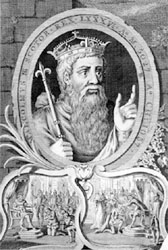Malcolm III Canmore King of Scotland 1883
- Born: Cir 1031 1883
- Marriage (1): Ingibjorg Finnsdottir about 1066 1884
- Marriage (2): Saint Margaret Queen of Scotland circa 1070 1884
- Died: 13 Nov 1093, Alnwick, Northumberland, England about age 62 1883

 General Notes: General Notes:
Founder of the dynasty that consolidated royal power in the Scottish kingdom.
The son of King Duncan I (reigned 1034-40), Malcolm lived in exile in England during part of the reign of his father's murderer, Macbeth (reigned 1040-57). Malcolm killed Macbeth in battle in 1057 and then ascended the throne. After the conquest of England by William the Conqueror, in 1066, Malcolm gave refuge to the Anglo-Saxon prince Edgar the Aetheling and his sisters, one of whom, Margaret (later St. Margaret), became his second wife.
Malcolm acknowledged the overlordship of William in 1072 but nevertheless soon violated his feudal obligations and made five raids into England. During the last of these invasions he was killed by the forces of King William II Rufus (reigned 1087-1100). Except for a brief interval after Malcolm's death, the Scottish throne remained in his family until the death of Queen Margaret, the Maid of Norway, in 1290. Of Malcolm's six sons by Margaret, three succeeded to the throne: Edgar (reigned 1097-1107), Alexander I (1107-24), and David I (1124-53).
------------------------------------------------------------------------------
Born about 1045, died 16 Nov., 1092, was a daughter of Edward "Outremere", or "the Exile", by Agatha, kinswoman of Gisela, the wife of St. Stephen of Hungary. She was the granddaughter of Edmund Ironside. A constant tradition asserts that Margaret's father and his brother Edmund were sent to Hungary for safety during the reign of Canute, but no record of the fact has been found in that country. The date of Margaret's birth cannot be ascertained with accuracy, but it must have been between the years 1038, when St. Stephen died, and 1057, when her father returned to England. It appears that Margaret came with him on that occasion and, on his death and the conquest of England by the Normans, her mother Agatha decided to return to the Continent. A storm however drove their ship to Scotland, where Malcolm III received the party under his protection, subsequently taking Margaret to wife. This event had been delayed for a while by Margaret's desire to entire religion, but it took place some time between 1067 and 1070.
In her position as queen, all Margaret's great influence was thrown into the cause of religion and piety. A synod was held, and among the special reforms instituted the most important were the regulation of the Lenten fast , observance of the Easter communion, and the removal of certain abuses concerning marriage within the prohibited degrees. Her private life was given up to constant prayer and practices of piety. She founded several churches, including the Abbey of Dunfermline, built to enshrine her greatest treasure, a relic of the true Cross. Her book of the Gospels, richly adorned with jewels, which one day dropped into a river and was according to legend miraculously recovered, is now in the Bodleian library at Oxford. She foretold the day of her death, which took place at Edinburgh on 16 Nov., 1093, her body being buried before the high altar at Dunfermline.
In 1250 Margaret was canonized by Innocent IV , and her relics were translated on 19 June, 1259, to a new shrine, the base of which is still visible beyond the modern east wall of the restored church. At the Reformation her head passed into the possession of Mary Queen of Scots, and later was secured by the Jesuits at Douai, where it is believed to have perished during the French Revolution . According to George Conn, "De duplici statu religionis apud Scots" (Rome, 1628), the rest of the relics , together with those of Malcolm, were acquired by Philip II of Spain, and placed in two urns in the Escorial. When, however, Bishop Gillies of Edinburgh applied through Pius IX for their restoration to Scotland, they could not be found.
The chief authority for Margaret's life is the contemporary biography printed in "Acta SS.", II, June, 320. Its authorship has been ascribed to Turgot, the saint's confessor, a monk of Durham and later Archbishop of St. Andrews, and also to Theodoric, a somewhat obscure monk; but in spite of much controversy the point remains quite unsettled. The feast of St. Margaret is now observed by the whole Church on 10 June.
From: http://www.newadvent.org/cathen/09655c.htm 1883

 Life Events: Life Events:
1. Acceded: King of Scotland, 1058. 1883

Malcolm married Ingibjorg Finnsdottir about 1066.1884 (Ingibjorg Finnsdottir died before 1070 1884.)

Malcolm next married Saint Margaret Queen of Scotland circa 1070.1884 (Saint Margaret Queen of Scotland was born about 1045 and died on 16 Nov 1092.)
|



 General Notes:
General Notes: